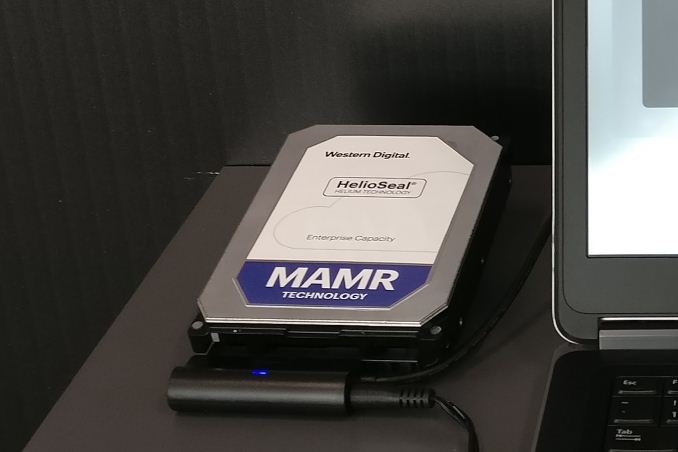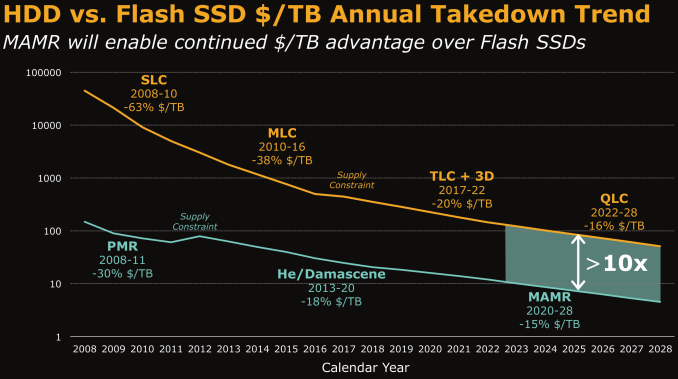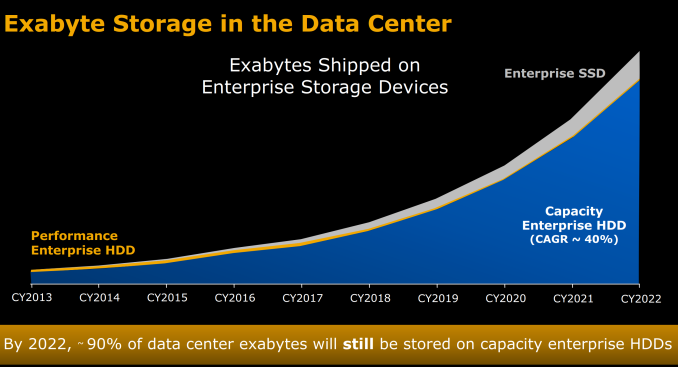Western Digital Stuns Storage Industry with MAMR Breakthrough for Next-Gen HDDs
by Ganesh T S on October 12, 2017 8:00 AM EST
Yesterday, Western Digital announced a breakthrough in microwave-assisted magnetic recording (MAMR) that completely took the storage industry by surprise. The takeaway was that Western Digital would be using MAMR instead of HAMR for driving up hard drive capacities over the next decade. Before going into the specifics, it is beneficial to have some background on the motivation behind MAMR.
Hard drives may be on the way out for client computing systems, but, they will continue to be the storage media of choice for datacenters. The Storage Networking Industry Association has the best resources for identifying trends in the hard drive industry. As recently as last year, heat-assisted magnetic recording (HAMR) was expected to be the technology update responsible for increasing hard drive capacities.

Slide Courtesy: Dr.Ed Grochowski's SNIA 2016 Storage Developer Conference Presentation
'The Magnetic Hard Disk Drive: Today’s Technical Status and Its Future' (Video, PDF)
Mechanical Hard Drives are Here to Stay
One of the common misconceptions amongst readers focused on consumer technology relates to flash / SSDs rendering HDDs obsolete. While using SSDs over HDDs is definitely true in the client computing ecosystem, it is different for bulk storage. Bulk storage in the data center, as well as the consumer market, will continue to rely on mechanical hard drives for the foreseeable future.
The main reason lies in the 'Cost per GB' metric.
Home consumers are currently looking at drives to hold 10 TB+ of data, while datacenters are looking to optimize their 'Total Cost of Ownership' (TCO) by cramming as many petabytes as possible in a single rack. This is particularly prevalant for cold storage and archival purposes, but can also expand to content delivery networks. Western Digital had a couple of slides in their launch presentation yesterday that point towards hard drives continuing to enjoy this advantage, thanks to MAMR being cost-effective.
Despite new HDD technology, advancements in solid state memory technology are running at a faster pace. As a result SSD technology and NAND Flash have ensured that performance enterprise HDDs will make up only a very minor part of the total storage capacity each year in the enterprise segment.
The projections presented by any vendor's internal research team always need to be taken with a grain of salt, but given that SanDisk is now a part of Western Digital the above market share numbers for different storage types seem entirely plausible.
In the next section, we take a look at advancements in hard drive technology over the last couple of decades. This will provide further technical context to the MAMR announcement from Western Digital.












127 Comments
View All Comments
tuxRoller - Friday, October 13, 2017 - link
How often do you run backups?sonofgodfrey - Thursday, October 12, 2017 - link
40 TB (40,000,000,000,000 bytes) @ 550 MB/s (which would expect from the density increase) gives about 20 hours to write or read the whole drive (assuming you can drive it at the speed the whole time). This may require an HDD with a direct PCIe connection. :0Jaybus - Monday, October 16, 2017 - link
SATA 3 is 600 MB/s, so should be adequate. Generally, the SATA controller is connected via PCIe. The bottleneck is still the read and write speeds to/from the media. It is what it is. If it were a 40 TB PCIe SSD with 2 GB/s read speed, it would still take almost 6 hours.Threska - Thursday, October 12, 2017 - link
Just wait till you see what that is in SSDs.Arbie - Thursday, October 12, 2017 - link
Since MAMR needs 'only' a new type of head and can use today's platters etc, the MAMR drives will not actually cost much more to make. WD will of course price them high at first, if only to recoup the R&D costs. But when the technology spreads, the price will drop rapidly.edgineer - Thursday, October 12, 2017 - link
This is interesting, and I'm glad WD is still innovating.But, I still wonder if they are ever planning on changing the deceptive capacity labeling. Is that 40 "TB" hard drive going to be 36 TiB?
The missing space just keeps growing... If you could do me a favor, Anandtech, please put a GiB or TiB figure next to the manufacturer's labeled size in your reviews, so I won't need to use a calculator.
MajGenRelativity - Thursday, October 12, 2017 - link
While I agree with the frustration, technically manufacturers aren't lying if they say 40 TB, because if the drive has 40 billion bytes, then it IS 40 TB.ddriver - Thursday, October 12, 2017 - link
except that tera is for a trillion, not billionDr. Swag - Thursday, October 12, 2017 - link
You know they meant trillion :PMajGenRelativity - Thursday, October 12, 2017 - link
I did mean trillion, my bad